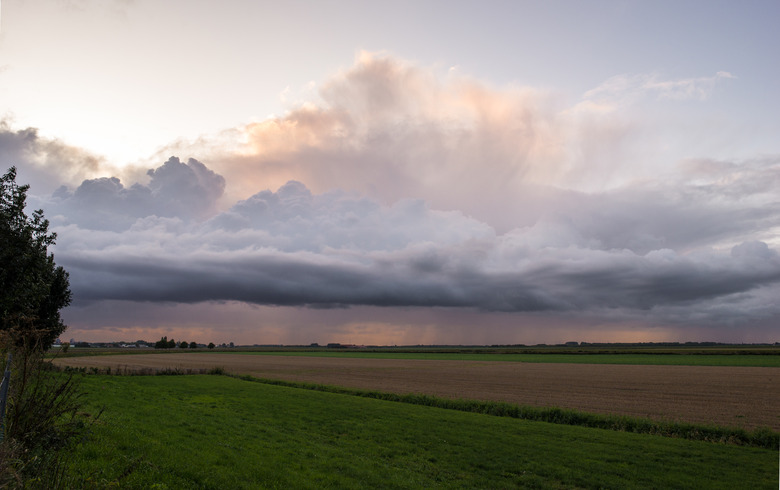Four Types Of Rain
Rain is rain, right? It's wet and falls from the sky. Actually, it's not quite so simple, because snow and hail are also types of rain, and a summer shower is not the same as a frontal thunderstorm or a monsoon. Scientists recognize four different kinds of raindrops as well as four different types of rainfall.
Temperature gradients and air moisture content are the main determinants of the characteristics of the raindrops that fall at a particular time and place. On the other hand, wind patterns and topography govern rainfall. These factors can combine to produce a light drizzle, a torrential rainfall, a snowstorm and every other variation of precipitation that occurs around the globe.
Four Types of Raindrops
Four Types of Raindrops
You've probably encountered each of the four different types of raindrops, unless you live in a specialized climactic area, such as a desert. Condensation occurs in clouds that form when moisture-laden warm air interacts with cold air, and the condensation falls out of the clouds as precipitation. The form that precipitation takes when it reaches the ground depends on the temperature in the clouds, the temperature on the ground and temperature in between.
**Rain:** This is the wet stuff that nourishes plants and for which umbrellas were invented. It occurs when both the cloud temperature and ground temperature are above freezing, and it can take three forms. It's known simply as rain when the drops are about 0.5 mm (0.02 in) in diameter, drizzle when the drops are smaller than that and virga when the drops are so small they don't reach the ground.
**Snow:** When both the temperature in the clouds and that on the ground are below the freezing point of water, 0 degrees Celsius (32 degrees Fahrenheit), condensed water droplets become ice crystals and fall to the ground as snow.
**Sleet:** Sleet occurs when the temperature in the clouds is warmer than that on the ground. Condensation falls as rain and partially freezes, and the precipitation that reaches the ground is a mixture of snow and water.
**Hail:** Sometimes rain encounters a layer of freezing air on its way to the ground and solidifies into raindrop-sized – or larger – ice pellets known as hailstones. They can pelt the ground even if the ground temperature is above freezing. Hail is a common feature of severe summer thunderstorms.
Four Types of Rainfall
Four Types of Rainfall
The movement of hot and cold air masses relative to each other is primarily responsible for the different rainfall patterns that occur around the world. Some of these air movements are localized, some due to ground topography and some due to seasonal planetary winds.
**Conventional rainfall:** Air naturally rises when it heats up, and it cools when it reaches higher elevations. Cool air can't hold as much moisture as warm air, so the moisture condenses into clouds known as cumulus clouds. Eventually, the clouds become so laden with moisture that rain starts to fall. This can happen over land or water as long as moisture is present. When it happens over tropical oceans, where the air is saturated with water, intense heat can cause strong upward convention currents. The combination of wind and moisture can create a tropical storm or hurricane.
**Orographic rainfall:** When moisture-laden air encounters a mountain range, the air is forced to rise. It cools off at the higher elevation, and this condenses water out of the air and creates rainfall. If the temperature is cold enough, the precipitation falls as snow.
**Frontal rainfall:** The meeting of a large mass of cold air and a large mass of warm air is called a front. The meeting creates turbulence. A frontal rain diagram can illustrate how the warm air rises over the cold air and forms large clouds when it cools, and moisture condenses. Thunderstorms, complete with lightning, usually result, and they can last anywhere from a few minutes to an hour or more.
**Monsoonal rainfall:** The combination of the sun's heat and the Earth's rotation creates a band of easterly winds at 30 degrees north and south latitude. These winds blow all year, but they change direction with the seasons. This seasonal shift is responsible for monsoon rains that fall in India, Southeast Asia and other places.
Cite This Article
MLA
Deziel, Chris. "Four Types Of Rain" sciencing.com, https://www.sciencing.com/four-types-rain-8158409/. 22 November 2019.
APA
Deziel, Chris. (2019, November 22). Four Types Of Rain. sciencing.com. Retrieved from https://www.sciencing.com/four-types-rain-8158409/
Chicago
Deziel, Chris. Four Types Of Rain last modified March 24, 2022. https://www.sciencing.com/four-types-rain-8158409/
